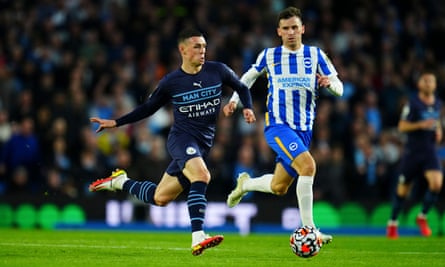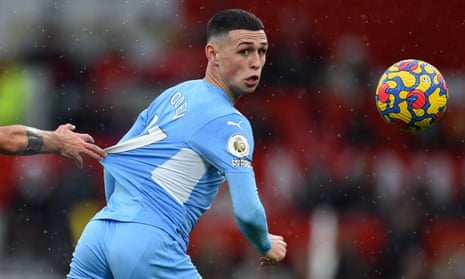It seems remarkable that there was a time, not so long ago, when the Premier League was seen as holding England back. Only about a third of its players were England-qualified, the argument went, and so opportunities for English youth were restricted. The Premier League has many problems and causes many problems, and for the vast majority of young players perhaps it is difficult to secure game time. But for those at elite level it can be a useful finishing school, offering the most promising young players regular high-class opposition and the very best teachers.
These are extraordinary times for English football. Imagine you are picking the squad for next year’s World Cup. Assuming the 3-4-2-1 Gareth Southgate fielded against Albania and San Marino is the default, there are perhaps five spaces available for the two inside-forward roles to operate either side of Harry Kane – which, along with right-back, is the area of real strength.
When was the last time that was true? English football has traditionally produced centre-backs and centre-forwards, hard-grafting midfielders and reliable goalkeepers. It has not really done position-defying craft and creativity.
Raheem Sterling is the man in possession, and was probably England’s best attacking player at the Euros. Mason Mount is loved by coaches for his tactical intelligence. Then there’s Jack Grealish, Bukayo Saka, Emile Smith Rowe, Marcus Rashford, Mason Greenwood, Callum Hudson-Odoi and Jadon Sancho, none of them older than 26. But it feels increasingly as though this season may be witnessing the emergence of the greatest of them all: Phil Foden.

The fretting over whether he was getting enough pitch time is ebbing. Pep Guardiola’s panegyrics to his ability sound increasingly sincere. The excitement at an emerging talent and the lust to see him as often as possible shouldn’t occlude the desirability of patience, of the benefits of letting him develop at his own pace.
Guardiola may turn out to have got it just right; certainly it’s easy to see his influence on the player Foden is becoming. Discomfort at where the money comes from is reasonable, and there probably should be a moral reckoning: English football undoubtedly benefits from the fact the Premier League can afford to recruit the best coaches in the world.
It’s not only Foden’s poise and vision, his 87.6% pass completion rate and average of 1.4 key passes a game, his work rate and his positioning: it’s his versatility. He may have scored only three goals this season and registered one assist (although in six league starts, that’s a perfectly reasonable strike rate), and he may not top any charts for chance creation or for dispossessing opponents, but that’s largely because his range has been so varied. This season, he has been used in at least five different roles.
Role A: Chelsea 0 Manchester City 1, Premier League, 25 September 2021. City set up, as so often, in a 4-3-3, with Foden the central forward between Gabriel Jesus and Grealish. His role was very much as a false 9. He had only 32 touches in the game and didn’t register a shot, but made 27 pressures and was a key factor in the way City smothered Chelsea – although he also created four shooting opportunities. This was the centre-forward as midfielder.
Role B: Liverpool 2 Manchester City 2, Premier League, 3 October 2021. That James Milner, usually such an unflappable emblem of calm efficiency, should have been fortunate not to be sent off said everything about how Foden, playing on the left of a front three, tormented him. He went past him on the inside, he went past him on the outside, and he effectively neutralised Liverpool’s right-back as an attacking threat by constantly hitting the space behind him. His goal capped a complete performance that included 19 pressures and 30 carries, seven of them of more than five metres.

Role C: Andorra 0 England 5, World Cup qualifier, 9 October 2021. England started in a 4-3-3, with Foden not as one of the three forwards but on the left side of midfield, sitting deep and measuring passes into the narrow space behind the Andorra defence, a ploy that was undeniably effective.
Against better opposition, perhaps Foden would be less successful in that more withdrawn role, his creative instincts compromised by the hurly-burly, but against a deep-lying defence his ability to calibrate a pass was hugely important.
Role D: Brighton 1 Manchester City 4, Premier League, 23 October 2021. Foden played in the middle of a front three and while there were occasions on which he dropped deep, he operated almost as an orthodox centre-forward, harrying the Brighton defence and scoring twice. It helped that Brighton played with a high line, but he repeatedly made dangerous runs in behind. He had eight shots in that game, four of them on target.
Role E: England 5 Albania 0, World Cup qualifier, 12 November 2021. Foden started as the right-sided forward in a 3-4-3 and linked well with Reece James as England pulled Albania apart before half-time, transforming what could have been an awkward game into a stroll.
It was his corner that brought the fifth goal, but more significant was the intelligence of his movement and passing, the way he kept the ball moving, never letting Albania settle. At the Euros he had looked out of sorts on the right but here, and then in the first half against San Marino, he was running games from that flank.
“I like Phil for the fact he knows how to play football,” Guardiola has said. “We can have an extra man in the positions we want to play, to pass the ball you have in certain areas to have more players.” That sort of positional intelligence and ability to improvise within a defined framework has traditionally been rare in English players.
And that, perhaps, is the most significant detail. It’s not only that Foden is technically gifted and works hard; it’s that he is tactically smart as well. And that intelligence, with the guidance of Guardiola, means it looks as though he could be very special indeed.

